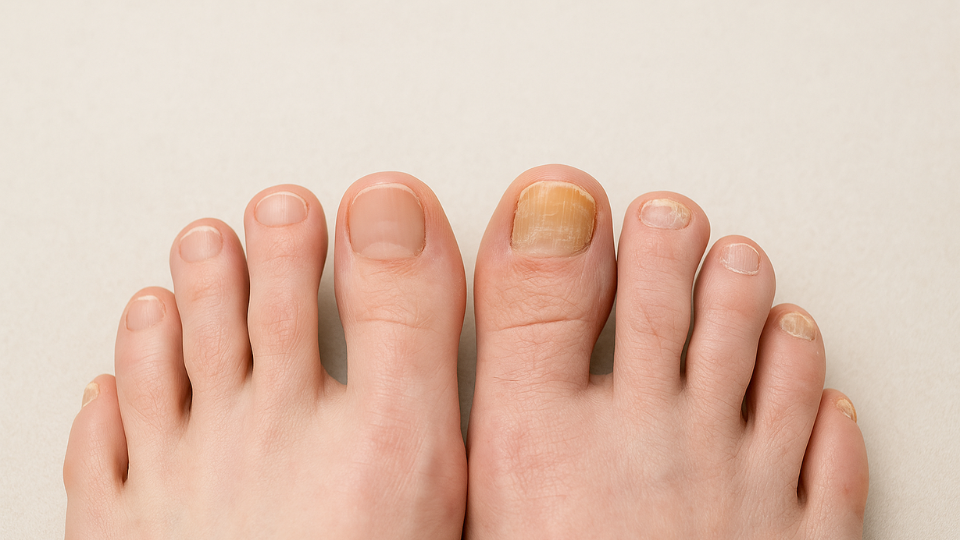
If you’ve struggled with toenail fungus and noticed that other family members have it too, you might wonder: is toenail fungus hereditary?
Toenail fungus, also known as onychomycosis, is one of the most common nail conditions treated by podiatrists. While it can cause thick, brittle, or discolored nails, the real frustration often comes when the infection keeps coming back.
In this article, we’ll explain whether nail fungus can be passed down through families, what truly causes it, and how to protect your feet, even if toenail fungus seems to “run in the family.”
Is Nail Fungus Hereditary or Contagious?
This is one of the most common questions patients ask: is nail fungus hereditary, or do you just catch it from someone else?
The short answer is that toenail fungus itself is not hereditary, you don’t inherit the fungus from your parents. However, you may inherit certain genetic traits that make you more prone to infection.
According to the National Library of Medicine, some people have immune or nail-structure differences that make them more likely to develop fungal infections when exposed. The British Association of Dermatologists also notes that while fungal infections aren’t directly inherited, they often spread among family members who share bathrooms, shoes, or nail tools.
In simple terms: You can’t inherit the fungus itself, but you can inherit nails, skin, or immune traits that make you more likely to get it. That combination of genetics and shared environments is what often makes toenail fungus appear to “run in families.”
What Causes Toenail Fungus?
Toenail fungus develops when fungal organisms, usually dermatophytes, infect the nail bed or the skin underneath. These fungi thrive in warm, damp environments such as locker rooms, tight shoes, or public showers.
Common causes include:
- Walking barefoot in public areas
- Wearing tight or non-breathable shoes
- Using unsterilized nail tools
- Excessive sweating or poor circulation
- Chronic health issues such as diabetes or low immunity
It’s important to understand that toenail fungus is an infection, not a disease you’re born with. The fungus enters through small cracks or openings in the nail and can spread if left untreated.
Many people who have toenail fungus also experience athlete’s foot (a skin infection caused by the same fungi). Treating both helps prevent reinfection. If you’re noticing itching, burning, or peeling between your toes, read our related guide: How to Relieve Pain from Athlete’s Foot: A Comprehensive Guide by Foot and Ankle Specialists.
Why Toenail Fungus Often “Runs in Families”
If multiple people in your household have toenail fungus, it may not be coincidence. Here’s why:
1. Genetic Susceptibility: Some people inherit nail or immune traits that make fungal infections more likely and harder to fight off.
2. Shared Environments: Bathrooms, showers, and shared footwear can harbor fungal spores, allowing the infection to spread from one person to another.
3. Common Health Conditions: Issues such as diabetes, poor circulation, or neuropathy often cluster within families, increasing fungal risk.
In most cases, toenail fungus appears hereditary because families share both genetic predispositions and daily habits that make fungal growth easier.
Who’s Most at Risk for Toenail Fungus?
Although anyone can get toenail fungus, certain groups are more likely to develop it:
- Adults over 60
- People with diabetes or circulation problems
- Those with weakened immune systems
- Athletes and gym-goers
- Individuals with a family history of fungal infections
- Anyone who wears enclosed shoes for long hours
If these apply to you, preventive care and early podiatric attention can make a major difference.
How to Prevent Toenail Fungus Even If It “Runs in the Family”
Even if toenail fungus runs in your family, consistent foot care can help you avoid it.
Prevention tips:
- Keep your feet clean and dry, especially between toes.
- Choose breathable shoes and moisture-wicking socks.
- Change socks daily and rotate your footwear.
- Avoid sharing shoes, nail tools, or towels.
- Disinfect showers, mats, and nail clippers regularly.
- Use antifungal powder or spray if you sweat heavily.
- Schedule yearly podiatry visits for nail and skin checks.
You might also like: When to See a Podiatrist: 10 Signs You Shouldn’t Ignore.

Treatment Options for Persistent Toenail Fungus
If your nail fungus doesn’t clear with over-the-counter products or keeps coming back, a podiatrist can help identify the cause and recommend targeted treatment.
At FAS The Woodlands, we offer:
- Prescription antifungal medications (topical or oral)
- Professional nail debridement for thick or painful nails
- Ongoing prevention care for patients with chronic recurrence
Your podiatrist will determine the exact fungal strain and choose the most effective treatment plan to help restore clear, healthy nails.
Getting Expert Help for Stubborn Toenail Fungus
Even if your family members have struggled with nail fungus, you don’t have to live with it. With early evaluation and proper treatment, most infections can be cleared, and future outbreaks prevented.
At FAS The Woodlands, our experienced podiatrists combine advanced treatments with personalized care to help patients safely and effectively recover from stubborn toenail fungus. We remind every patient that while toenail fungus is common, it’s also highly treatable, with the right plan and consistent care, healthy nails can be fully restored.
Book an Appointment Today to take the first step toward healthy, confident feet.
📍 Serving The Woodlands, Huntsville, and Houston.
Read Our Latest Blog

Sweaty Feet: Causes, Treatment, and How to Keep Your Feet Dry
Learn what causes sweaty feet, why feet can be cold and sweaty at the same time, and how to stop sweaty feet effectively. Discover treatment options from podiatric experts at FAS The Woodlands.



